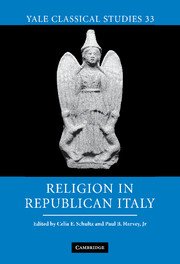Book contents
- Frontmatter
- Contents
- List of illustrations
- List of contributors
- Acknowledgments
- List of abbreviations
- Introduction
- Chapter 1 Reconsidering “religious Romanization”
- Chapter 2 In search of the Etruscan priestess: a re-examination of the hatrencu
- Chapter 3 Etruscan religion at the watershed: before and after the fourth century bce
- Chapter 4 Religious locales in the territory of Minturnae: aspects of Romanization
- Chapter 5 Religion and memory at Pisaurum
- Chapter 6 Inventing the sortilegus: lot divination and cultural identity in Italy, Rome, and the provinces
- Chapter 7 Hot, cold, or smelly: the power of sacred water in Roman religion, 400–100 bce
- Chapter 8 Religion and politics: did the Romans scruple about the placement of their temples?
- Chapter 9 Juno Sospita and Roman insecurity in the Social War
- Chapter 10 Beyond Rome and Latium: Roman religion in the age of Augustus
- Bibliography
- Index
Chapter 4 - Religious locales in the territory of Minturnae: aspects of Romanization
Published online by Cambridge University Press: 08 January 2010
- Frontmatter
- Contents
- List of illustrations
- List of contributors
- Acknowledgments
- List of abbreviations
- Introduction
- Chapter 1 Reconsidering “religious Romanization”
- Chapter 2 In search of the Etruscan priestess: a re-examination of the hatrencu
- Chapter 3 Etruscan religion at the watershed: before and after the fourth century bce
- Chapter 4 Religious locales in the territory of Minturnae: aspects of Romanization
- Chapter 5 Religion and memory at Pisaurum
- Chapter 6 Inventing the sortilegus: lot divination and cultural identity in Italy, Rome, and the provinces
- Chapter 7 Hot, cold, or smelly: the power of sacred water in Roman religion, 400–100 bce
- Chapter 8 Religion and politics: did the Romans scruple about the placement of their temples?
- Chapter 9 Juno Sospita and Roman insecurity in the Social War
- Chapter 10 Beyond Rome and Latium: Roman religion in the age of Augustus
- Bibliography
- Index
Summary
In recent years, the territory of Minturnae has been the focus of research that has borne fruit in studies on the region's topography, on the findings of archaeological excavation, and on the re-examination of material and architectural evidence. The present discussion considers the Romanization of Minturnae in terms of the region's various cult sites as they are known at present from archaeological material dating as late as the mid-first century bce. Much of the relevant evidence for this study consists of published and unpublished material remains (terracotta votives and architectural pieces) now widely dispersed in museum collections throughout Italy and in the United States, as well as items known only from older and more recent excavation records.
An examination of the evidence for cultic activity in the area of Minturnae has shown, on the one hand, continuous activity at the older sanctuaries of the indigenous Aurunci (represented by the sanctuary at Monte d'Argento and by two archaic edifices in the sanctuary of Marica) down to the Roman period and, on the other hand, the inclusion in newer settlement areas of construction of typically Roman cult sites (such as the Temple of Jupiter and the Capitolium in the colony of Minturnae and the architectural decoration of those locales).
- Type
- Chapter
- Information
- Religion in Republican Italy , pp. 90 - 116Publisher: Cambridge University PressPrint publication year: 2006
- 3
- Cited by



